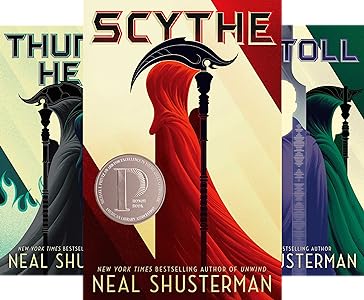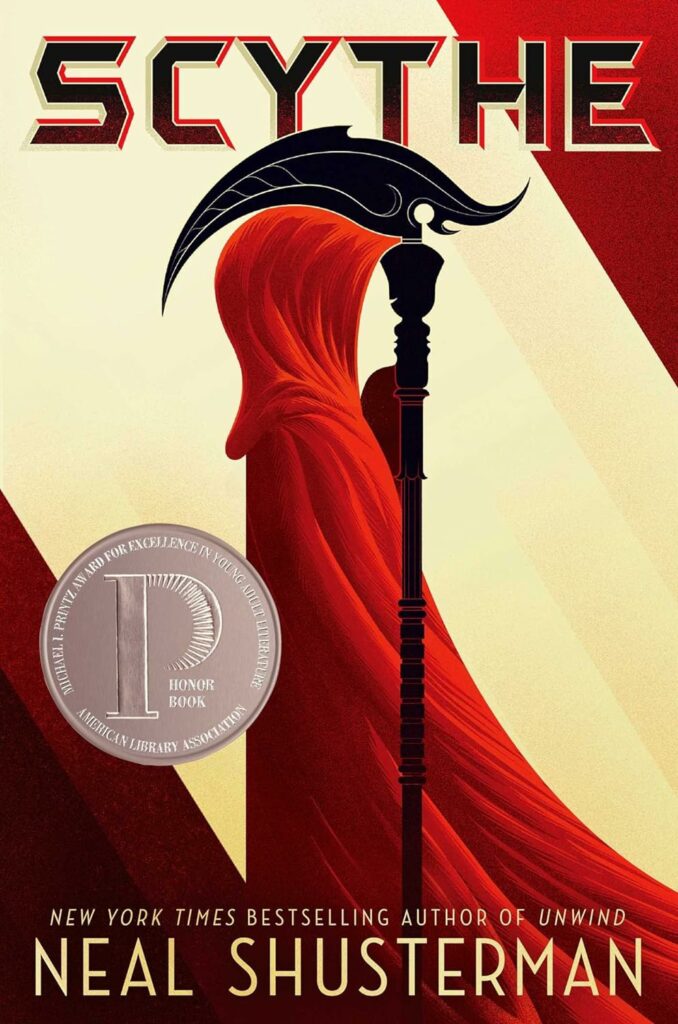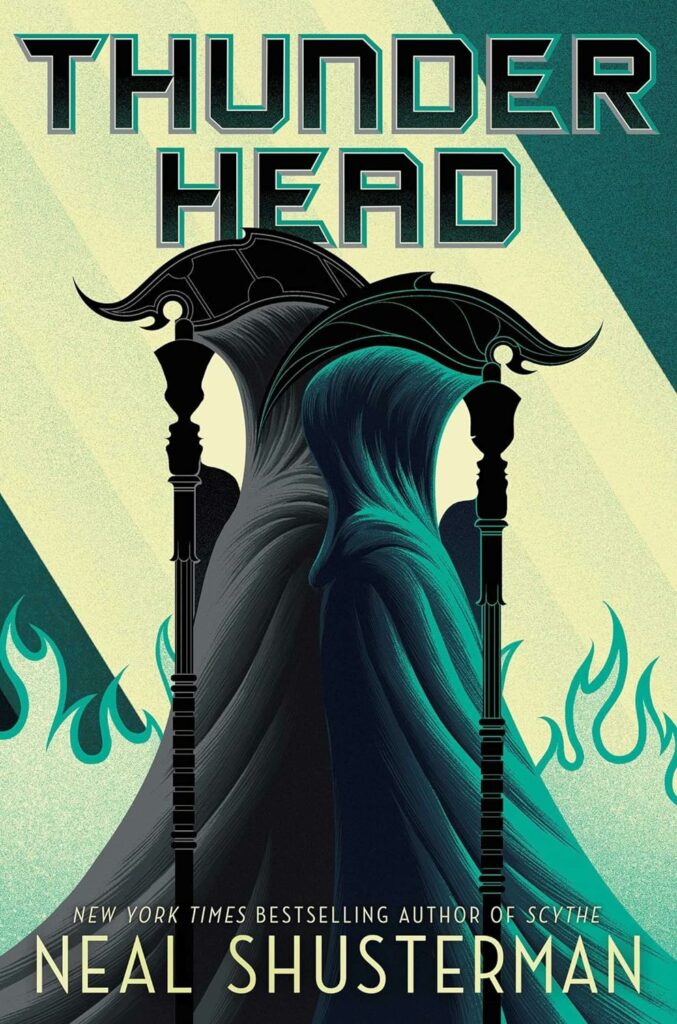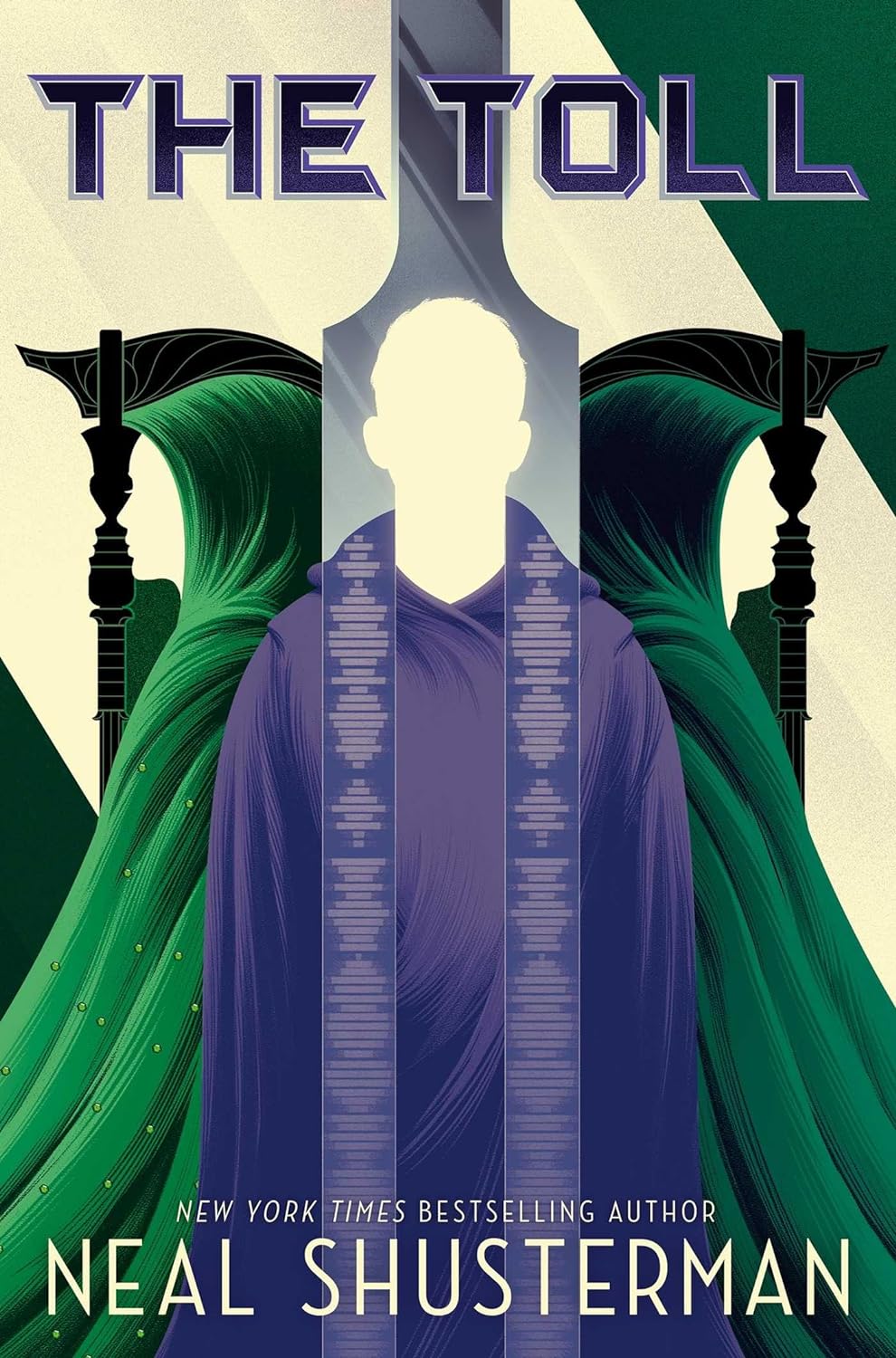The Arc of a Scythe Trilogy is a thought-provoking dystopian series for mature teens; it has problematic elements but raises good questions about the essential nature of humanity.
Arc of a Scythe Trilogy by Neal Shusterman. Simon & Schuster.

- Scythe, 2017. 464 pages.
- Thunderhead, 2019. 512 pages.
- The Toll, 2020. 640 pages.
Reading Level: Teens, ages 12 and up.
Recommended For: Teens, ages 15 and up. (See below for considerations)
Neal Shusterman recently won the Margaret A. Edwards Award, a prestigious award from the American Library Association, that recognizes an author’s “lifetime achievement in writing for young adults.” Several of his works were specifically mentioned, including his Arc of a Scythe trilogy. Unwind and Challenger Deep also garnered praise, both of which Janie has reviewed. Challenger Deep also won the National Book Award the year it was published. Scythe, the first book in the Arc of a Scythe trilogy, won a Printz honor (the award for YA literature that is roughly analogous to the Newbery for younger readers).
As you might surmise, when an author of this calibre writes a dystopian trilogy, it’s going to be well-written and thought-provoking. The problems arise when this same skillful author includes elements that we might squirm over: they appear compelling and our defenses are down. But before we dive in, am I the only one who finds these book covers utterly striking?
Arc of a Scythe #1: Scythe

I reviewed this book earlier on its own because I think it stands alone, and it’s the best of the three. It’s also free of some of the more troubling aspects the second two books include.
To recap, Citra and Rowan are selected to be scythe apprentices to Scythe Faraday; together, they will learn the art (and skill) of gleaning under his wise, capable leadership. In their futuristic society, all natural means of death (such as illness) have been eradicated. Additionally, healing nanites can repair any injury, even ones that cause death. The only way a person can be permanently removed is to be gleaned (um, killed) by a scythe. Scythes are the only ones granted this power, and they are governed by their own set of commandments. All other citizens, and, indeed, all of society and infrastructure, are governed and managed by the Thunderhead, an all-knowing “cloud” much like our current AI attempts. As Citra and Rowan get closer to their final tests, both learn more about the underside of the Scythe organization. And they are presented with a terrible option at the end.
Arc of a Scythe Trilogy #2: Thunderhead

Note: it’s impossible to review the following two books without significant spoilers for the first volume!
Rowan has gone rogue as Scythe Lucifer; he is single-handedly wielding vigilante justice against scythes (such as Scythe Goddard) who have abandoned their precious role of stewardship in favor of the more sinister killing and mass gleaning. Citra is earning respect the traditional route in her new role as Scythe Anastasia; she works closely with the much-lauded Scythe Curie. Meanwhile, we meet a new character, Greyson.
Greyson has lived a normal, uneventful life up to this point. He has a peculiar relationship with the Thunderhead, the AI cloud that governs their world. The two “talk” or communicate, much like an uncle and nephew or mentor and mentee. Greyson takes a new job working directly for the Thunderhead, but he is abruptly cast out, marked “unsavory.” Is this because he needs to spy for the Thunderhead? To go undercover, as it were? Or is the Thunderhead malfunctioning? And if scythes are going rogue, can the Thunderhead intervene? Is Greyson supposed to help?
Thunderhead raises so many questions! It’s impossible to read this novel without simultaneously evaluating our own growing dependence on AI platforms and tools. Will our tools become sentient? Will they get “too big for their britches”? How should ordinary humans respond? What is our responsibility? And, in light of Rowan’s vigilante spirit, when do we—if ever—have the right to kill in order to eliminate the truly unsavory elements of society? Is Citra’s law-abiding, but slower, route better? And who is trying to eliminate her? And the rest of the scythedom? Is someone nefarious out there pulling the strings? Is he or she bent on eliminating the entire scythedom?!
This book is a quick read, despite its hefty page count. It races to a true cliffhanger of an ending. And it raises more questions than it answers, as all good dystopian books do. However, it comes at a heftier price tag, in terms of considerations, than its predecessor above.
Considerations:
- Language: Profanity: Several instances of “oh my g–“, some “d—,” “h—“; Vulgarity: scattered common vulgar terms (a–, screw, b—-, …). Given the length of this book, this is not over the top, but nonetheless, the “language” consideration is more for this book than for the first.
- Sexuality: Nearly all of these instances are in reference to the villains or disreputable characters and serve to illustrate their character’s, well, character. One “unsavory” character, who is pretty unsavory by all normal definitions of the term, has male genitalia tattooed on her cheek. She also lives up the clubbing lifestyle, constantly seducing the aforementioned Gavin into her lifestyle. Casual banter relating to sexuality (“gonna join me in the shower?”) and mentions of sex by another two characters. Musings by the Thunderhead on at least one occasion of “closed-door-activity” as it calls sexual activity (the Thunderhead can see all and knows all). One character who reflects briefly on having seduced both the high school homecoming queen and king. One woman flat-out offers herself to her male superior (opening her robe, etc.), but no details are given. The final scene of the book is a discreet, but clear, reference to an unmarried man and woman becoming one.
- Violence: Given that this is a book about people who are tasked with killing in order to maintain the population, there is a significant amount of violence. Most isn’t gruesomely described.
Arc of a Scythe Trilogy #3: The Toll

Running in the background of the previous two books is a pseudo-religious following called the “Tonists” who worship the “Toll.” Monasteries abound, and the followers of the Toll are exempt from some citizen/community requirements. This group is a thorn in the side of the “bad scythes,” and ignored by most other groups. Until now.
When a society crumbles, figureheads arise and lead the fragile people. Sometimes, these leaders are despotic, seizing upon a leadership vacuum in order to foster their own evil plans. Other times, a person is in the right place at the right time and accepts the mantle of leadership. Greyson has taken up sanctuary in a Toll monastery. When society is flailing in the wake of the mass destruction of so many scythes (end of book 2), Greyson becomes the Toll—or, rather, the voice of the Toll. In reality, he is communicating with the Thunderhead, but in a very roundabout manner. He, you might say, is the “good leader.” Scythe Goddard, on the other hand, has capitalized on the power vacuum and, like all good despots, is wielding a brutal scythe, literally and figuratively.
The Thunderhead is absolutely forbidden from communicating with scythes, or interfering with scythe business. But as society collapses, a now sentient Thunderhead is pondering big questions, including how to help the good scythes rebuild society.
Scythe Faraday returns in this volume, bent on solving an age-old mystery from scythe lore.
And Citra and Rowan resurface, also anxious to lead society towards healing.
It’s hard to describe this giant volume succinctly because so many of the details depend on a working knowledge of the first two books. Shusterman also adds an entirely new layer in this volume, with many new characters and technology. And, he includes yet more “considerations.”
Considerations:
- Language: several “d—” and “h—,” one “a–,” one “batsh–,” one “sh–, one “p—ing”
- Sexuality: A key character in this third volume is gender fluid, adapting to sunlight and shadow as he/she switches back and forth. This raises all sorts of issues, particularly when he/she is romantically attracted to others. The closing scene from book 2 is mentioned again near the beginning of this volume (again, no details).
- Violence: Same song, third verse.
Arc of a Scythe Trilogy as a Whole
The Arc of a Scythe trilogy is a fascinating thought experiment. What would happen if our technology advanced to such a level that it could function as the Thunderhead does? Will there ever be a time when we have truly eradicated all natural causes of death? When the earth’s resources are perfectly managed on behalf of everyone? What is the role of religion? Does it matter what that religion is?
Christians will have different answers for these sorts of questions than the average Scythe reader, but they are good ones for us to mull over. The Arc of a Scythe books urge us to reflect on what makes us truly human, what role our technology should play in our lives, how much power we should grant to that same technology, and what our future goals as a planet should include. This series also prompts us to reflect on our relationships with one another and with authority. Turns out, even in a futuristic society with no natural death, people are still people. Leaders rise and fall, through nefarious means or legitimate. People still fall in love. Individuals are still faced with moral and ethical conundrums, big and small. And even a technologically “perfect” world is still flawed. We can’t change the problem of the human heart by technology, can we?
This series comes with a long list of considerations, but mature teens should be able to handle it. The books read quickly, which means the language goes in one ear and out the other. Sexuality is certainly referenced, but is never graphically depicted, and the violence is similar. If your teens are reading classics like Brave New World, the Arc of a Scythe trilogy would make for very interesting companion reading.
Overall Rating: 4 out of 5
- Literary/Artistic Rating: 4
- Worldview Rating: 3.75/5
Read more about our ratings here.
Related Reading from Redeemed Reader
- A Book Review: Another thought-provoking dystopian novel that looks at the role of tech and what makes us human (but which comes with similar considerations) is Feed by M. T. Anderson.
- A Book Review: The Switch by Roland Smith is less intense, but a fun read for adventure-seeking teens.
- A Resource: Not quite ready for the Arc of a Scythe books? Check out our list of 15 Books for 15-Year-Old Boys for some other possibilities.
We are participants in the Amazon LLC affiliate program; purchases you make through affiliate links like the one below may earn us a commission. Read more here.
Stay Up to Date!
Get the information you need to make wise choices about books for your children and teens.
Our weekly newsletter includes our latest reviews, related links from around the web, a featured book list, book trivia, and more. We never sell your information. You may unsubscribe at any time.
Support our writers and help keep Redeemed Reader ad-free by joining the Redeemed Reader Fellowship.
Stay Up to Date!
Get the information you need to make wise choices about books for your children and teens.
Our weekly newsletter includes our latest reviews, related links from around the web, a featured book list, book trivia, and more. We never sell your information. You may unsubscribe at any time.
We'd love to hear from you!
Our comments are now limited to our members (both Silver and Golden Key). Members, you just need to log in with your normal log-in credentials!
Not a member yet? You can join the Silver Key ($2.99/month) for a free 2-week trial. Cancel at any time. Find out more about membership here.



